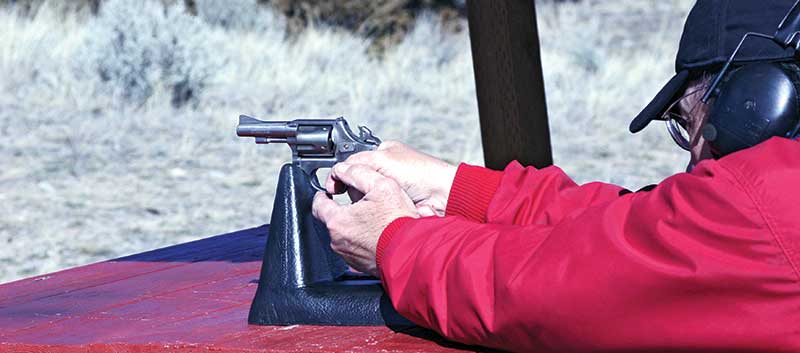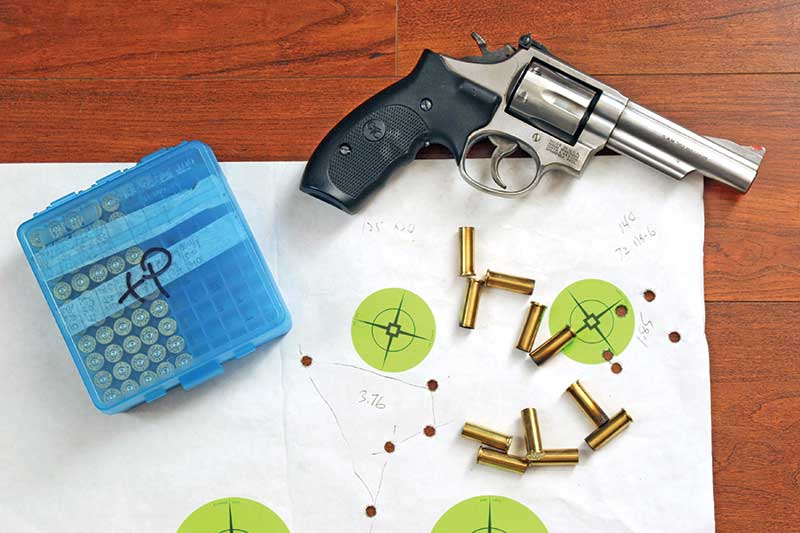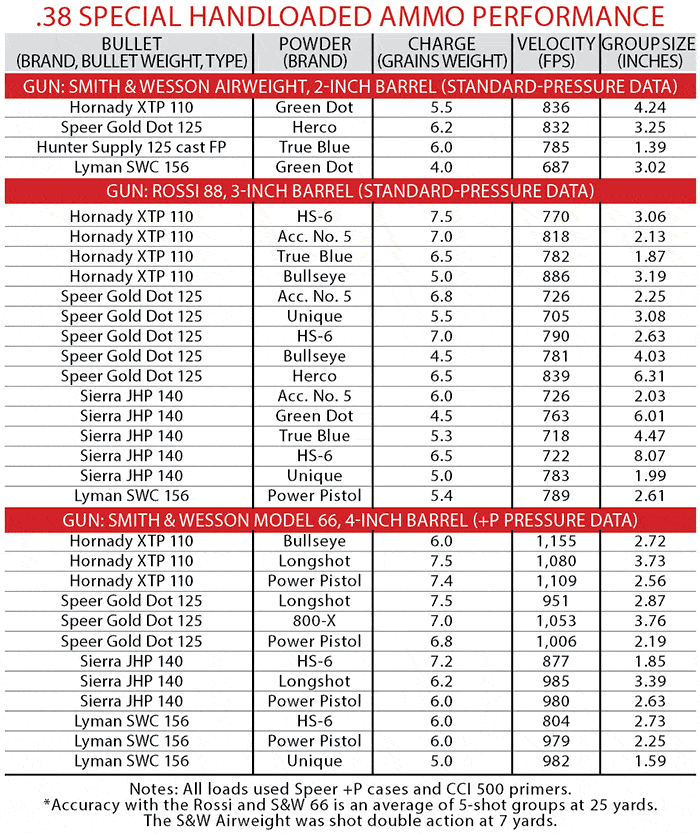The .38 Special
Still “Special” after
more than 100 years
The .38 Special is the most popular centerfire revolver cartridge ever, and still going strong. Not bad for a round introduced in 1899. Originally designed by Smith & Wesson for the US military after the .38 Long Colt was deemed inadequate, it also served as the standard, American police round until semi-autos took over during the past quarter-century.
It was once the centerfire target handgun round, though today the formal bull’s-eye shooting it dominated isn’t as popular as games more suitable to semi-autos. The .38 Special also works great for hunting smaller game, and while today’s handgun hunters consider it inadequate for big game, quite a few deer have been taken with the old round.
Today, however, the .38 Special is primarily a self-defense cartridge. Hard as might be for many enthusiasts to understand, not everybody who wants a self-defense handgun wants to be an expert. Instead they want a handgun that’s easy to shoot, both in recoil and “fire-control system,” and uses easily available ammunition. A double-action .38 Special revolver is the logical choice.
New buyers aren’t usually aware the .38 Special actually uses bullets 0.357-inch in diameter, and if told why their eyes would glaze over. The original .38 revolver cartridge, the Short Colt, originated back when cap-and-ball revolvers were being modified to shoot newfangled brass cartridges. One of the most-converted was the .36 Navy Colt, which actually fired a round ball of around .38 caliber. The original .38 Short Colt cartridge had a case and bullet diameter of approximately 0.380-inch, the size of the cylinders in the Navy Colt, with the smaller rear end of the bullet held by the case mouth. (This same arrangement is still used in .22 Long Rifle cartridges.)
After revolvers were designed for cartridges, Colt created the .38 Long Colt by lengthening the .38 Short’s case, but bullet diameter was approximately 0.36 so the lubricated portion of the bullet would fit inside the case. During the transition to smokeless powder, bullet diameter was standardized at 0.357- to 0.358-inch in both the Short and Long Colts.
The .38 Special is an elongated .38 Long Colt, designed in 1899 by Smith & Wesson. The Long Colt had been the official US Army cartridge since 1892, and had been found lacking in stopping power. It proved inadequate again when the US claimed the Philippines after the Spanish-American War and natives rose in rebellion, so S&W brought out a more powerful round.
According to Smith & Wesson historian Roy Jinks, the .38 Special was initially chambered in the .38 Hand Ejector Model of 1899. The ammunition was loaded with around 21 grains of black powder and a 158-grain bullet. Smokeless loads soon appeared with similar ballistics, but Phil Sharpe, in his massive book Complete Guide to Handloading, notes that charge was used in the original “balloon” style cases, made of thin, folded brass. Sharpe’s loading data for modern cases includes one black powder load, 18.0 grains of FFg, giving the 158-grain bullet 820 fps.
Ammo factories and handloaders continually attempted to hop up the .38 Special, but due to the limitations of the original revolvers the sensible solution was to lengthen the case yet again and offer it in stronger firearms. The result was 1934’s .357 Magnum, a cooperative creation involving Colonel D.B. Wesson, Elmer Keith and Phil Sharpe. Operating at twice the pressure of the .38 Special, the new round became a big success—partly because .38 Special cartridges can be fired in .357’s. (As can .38 Short and Long Colts, if your heart so desires.)
However, the .357 didn’t prevent further fiddling with the .38. Today there are two pressure levels of factory ammunition and handloading data. The SAAMI maximum average pressure (MAP) level for “standard” .38 ammo is 17,000 psi, and the +P MAP is 20,000 psi. This doesn’t sound like much but the extra 3,000 psi results in a noticeable increase in power and recoil, and lighter .38 revolvers tend to loosen with steady diet of +P loads.
(There was also a +P+ factory load for a while, but SAAMI doesn’t list a +P+ pressure level and the Federal, Remington and Winchester websites don’t list any such loads. Or at least I can’t find them. Life used to be easy when gun stores offered stacks of free catalogs with simple tables, but major ammo makers apparently hate user-friendly websites.)
Most .357-diameter handgun bullets are designed for .357 Magnum velocities, so won’t expand at lower velocities, though Speer offers a special 135-grain Gold Dot Short Barrel bullet. I couldn’t find any for the handload testing but data for the 140-grain bullet used will work.
GUNS publisher and American Handgunner editor Roy Huntington was a cop back when the .38 Special ruled. He likes heavier lead bullets, whether semi-wadcutters or real wadcutters. The “FBI load,” a hollowpoint 158-grain made of very soft lead, is also an option. I have a supply of Speer’s discontinued swaged 158-grain hollowpoints, but decided to hoard them rather than punch holes in paper, substituting bullets cast with my very first mold, the revered Lyman 358156.
The handloads were gleaned from a bunch of sources, and shot in three revolvers. Milder loads were mostly tested in an older stainless Rossi 88 with a 3-inch barrel, originally belonging to my stepfather-in-law. After “Doc” passed away, my wife Eileen and I were visiting her mother, an anti-gunner from New York City. One morning she entered the living room holding the Rossi by the very end of the butt and asked, “Can you get rid of this?”
I asked, “Is it loaded?”
She laughed. “Of course not!”
As she walked closer I could see bullets inside the chamber mouths, so gently grasping the Rossi around the cylinder and triggerguard, I said, “Yeah, I can get rid of it.”
It turned out to be a good little gun, with a crisp 3-pound single-action pull and smooth double-action pull. It weighs 21 ounces and is just the right size for a front jeans pocket. It’s also the only one of the test guns ever drawn for possible defense, when a loose German shepherd threatened us as we walked our Labrador along a local lakeshore. Eileen got the Lab on a leash and I got the Rossi aimed at the shepherd’s snarling head. Luckily its owner (a young blond in a bikini) finally noticed her dog misbehaving and called him from 150 yards away.
The S&W Airweight is Eileen’s city carry gun (she packs bigger stuff in the Montana mountains), and the +P loads were shot from my S&W Model 66 .357. The Rossi and 66 were shot over a rest at 25 yards, and the Airweight offhand and double-action at 7 yards, the traditional gunfight range. The brass was discontinued Speer +P, mostly because I have a bunch, but it weighs about the same as other +P brass, around 75 grains. (Standard .38 Special brass of several brands averaged 67 to 68 grains.)
Even the Airweight was pleasant to shoot, and the Rossi turned out to be pretty accurate with several loads, though when it didn’t like a load, it really didn’t like it. The shooting was a lot more fun than test-shooting bigger cartridges. Long live the long-lived .38 Special!
Four of John Barsness’s nine books are on firearms and shooting. His latest, Rifle Trouble-Shooting and Handloading, was published in 2012 by Deep Creek Press, and is available through www.riflesandrecipes.com, P.O. Box 579, Townsend, MT 59644, (406) 521-0273.
Accurate Powders
P.O. Box 158
Miles City, MT 59301
(406) 234-0430
www.accuratepowder.com
Alliant Powder
P.O. Box 6, Radford
VA 24143-0006
(800) 276-9337
www.alliantpowder.com
Hodgdon Powder Company
6430 Vista Drive
Shawnee, KS 66218
(913) 362-9455
www.hodgdon.com/warning/
Hornady Mfg. Co.
3625 Old Potash Hwy.
Grand Island, NE 68802-1848
(800) 338-3220
www.hornady.com
Hunter’s Supply Cast Bullets
(505) 716-4369
www.hunters-supply.com
Lyman Products Corp.
465 Smith Street
Middletown, CT 06457
(800) 225-9626
www.lymanproducts.com
Rossi Firearms
16175 NW 49 Ave., Miami, FL 33014
(305) 474-0401
www.rossiusa.com
Sierra Bullets
1400 West Henry Street
Sedalia, MO 65301
(660) 827-6300
www.sierrabullets.com
Smith & Wesson
2100 Roosevelt Avenue
Springfield, MA 01104
(413) 747-8300
www.smith-wesson.com

Get More Revolver Content Every Week!
Sign up for the Wheelgun Wednesday newsletter here:







